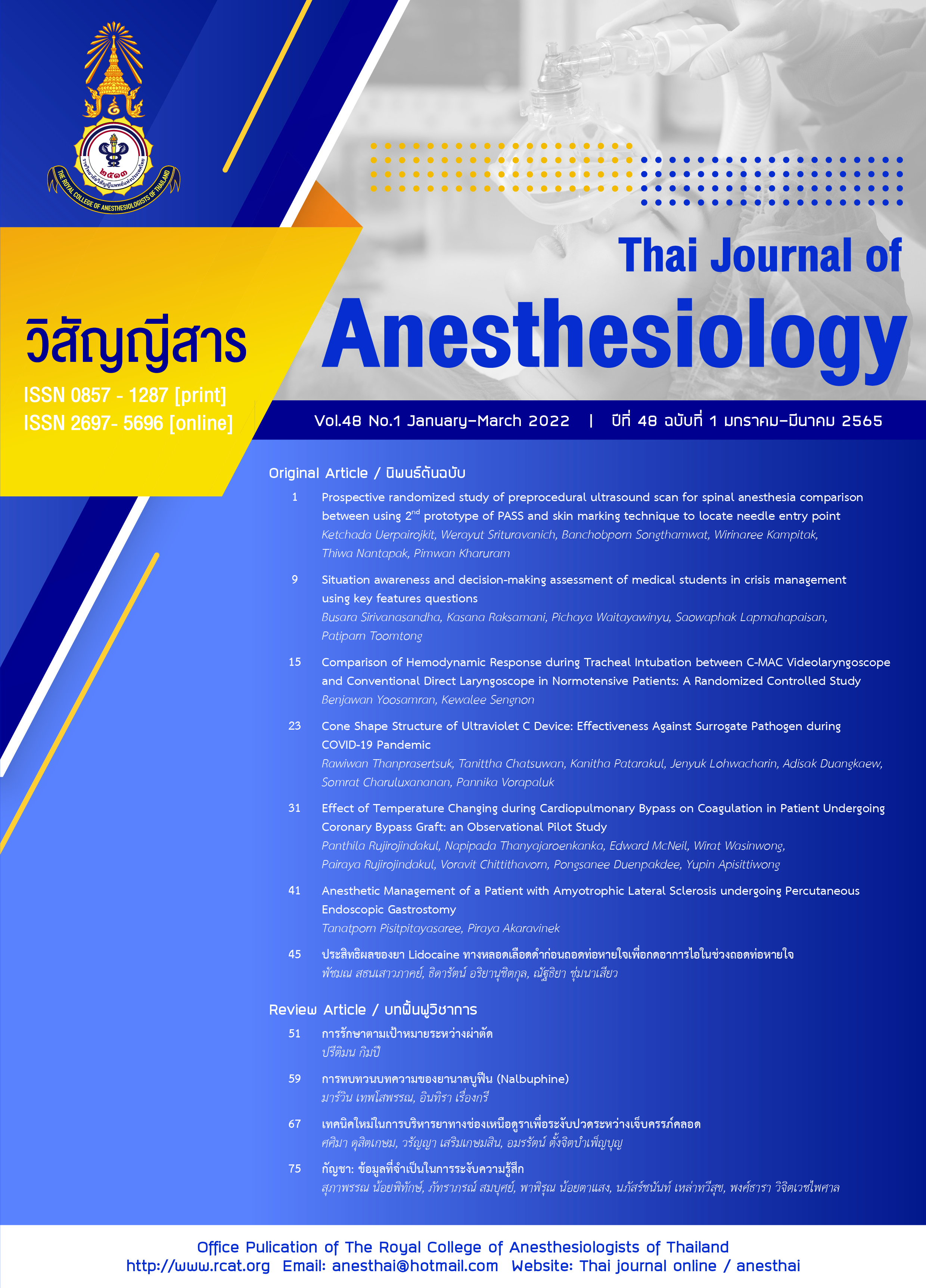Nalbuphine: A Collective Review
Main Article Content
Abstract
Nalbuphine is a synthetic agonist-antagonist opioid which has been introduced to clinical used for over 40 years. It antagonized µ2-opioid receptor while antagonized k-opioid receptor. Thai FDA has approved the use of nalbuphine for a treatment of moderate to severe pain. Opioid induced pruritus, which caused by the mu-opioid receptor activation can be effectively treated by nalbuphine, because nalbuphine is an antagonist to mu-opioid receptor. In Thai FDA does not categorized nalbuphine as not narcotics or controlled substances. There for, it more feasible to the clinical use when compare to other opioids. This collective review aims to summarize mechanism of action, pharmacology, efficacy, safety and evidence based clinical studies of nalbuphine for the benefit of anesthesiologists and general practitioners.
Article Details

This work is licensed under a Creative Commons Attribution-NonCommercial-NoDerivatives 4.0 International License.
References
Devin L, Christopher MV. Nalbuphine. Treasure Island (FL): StatPearls Publishing. 2020.
John BF, John WD, David MC. Analgesig agent. In: Morgan & Mikhail’s, Editors. Clinical Anesthesiology. Singapore: McGraw-Hill Education; 2013. p. 1392.
Zeng Z, Lu J, Shu C, et al. A comparision of nalbuphine with morphine for analgesic effects and safety: meta-analysis of randomized controlled trials. Sci Rep. 2015;5:10927.
Contet C, Kieffer BL, Befort K. Mu opioid receptor: a gateway to drug addiction. Curr Opin Neurobiol. 2004;14:370-8.
Trescot AM, Datta S, Lee M, Hansen H. Opioid pharmacology. Pain Physician. 2008;11(Suppl):S133-53.
Chen JC, Smith ER, Cahill M, Cohen R, Fishman JB. The opioid receptor binding of dezocine, morphine, fentanyl, butorphanol and nalbuphine. Life Sci. 1993;52:389-96.
Klepper ID, Rosen M, Vickers MD, Mapleson WW. Respiratory function following nalbuphine and morphine in anaesthetized man. Br J Anaesth. 1986;58:625-9.
Schnabel A, Reichl SU, Zahn PK, Pogatzki-Zahn E. Nalbuphine for postoperative pain treatment in children. Cochrane Database Syst Rev. 2014;7:CD009583.
Bressolle F, Khier S, Rochette A, Kinowski JM, Dadure C, Capdevila X. Population pharmacokinetics of nalbuphine after surgery in children. Br J Anaesth. 2011;106:558-65.
Jaillon P, Gardin ME, Lecocq B, et al. Pharmacokinetics of nalbuphine in infants, young healthy volunteers, and elderly patients. Clin Pharmacol Ther. 1989;46:226-33.
Giannina G, Guzman ER, Lai YL, Lake MF, Cernadas M, Vintzileos AM. Comparison of the effects of meperidine and nalbuphine on intrapartum fetal heart rate tracings. Obstet Gynecol. 1995;86:441-5.
Nicolle E, Devillier P, Delanoy B, Durand C, Bessard G. Therapeutic monitoring of nalbuphine: transplacental transfer and estimated pharmacokinetics in the neonate. Eur J Clin Pharmacol. 1996;49:485-9.
Anderson D. A review of systemic opioids commonly used for labor pain relief. J Midwifery Womens Health. 2011;56:222-39.
Jacqz-Aigrain E, Serreau R, Boissinot C, et al. Excretion of ketoprofen and nalbuphine in human milk during treatment of maternal pain after delivery. Ther Drug Monit. 2007;29:815-8.
Dinges HC, Otto S, Stay DK, et al. Side effect rates of opioids in equianalgesic doses via intravenous patient-controlled analgesia: A aystematic review and network meta-analysis. Anesth Analg. 2019;129:1153-62.
Deng C, Wang X, Zhu Q, Kang Y, Yang J, Wang H. Comparison of nalbuphine and sufentanil for colonoscopy: A randomized controlled trial. PLoS One. 2017;12:e0188901.
Yeh YC, Lin TF, Lin FS, Wang YP, Lin CJ, Sun WZ. Combination of opioid agonist and agonist-antagonist: patient-controlled analgesia requirement and adverse events among different-ratio morphine and nalbuphine admixtures for postoperative pain. Br J Anaesth. 2008;101:542-8.
Naaz S, Shukla U, Srivastava S, Ozair E, Asghar A. A comparative study of analgesic effect of intrathecal nalbuphine and fentanyl as adjuvant in lower limb oprthopaedic surgery. J Clin Diagn Res. 2017;11:UC25-8.
Ibrahim AS, Aly MG, Thabet ME, Abdelaziz MR. Effect of adding nalbuphine to intrathecal bupivacaine with morphine on postoperative nausea and vomiting and pruritus after elective cesarean delivery: a randomized double blinded study. Minerva Anestesiol. 2019;85:255-62.
Abdelhamid BM, Omar H. Nalbuphine as an adjuvant to 0.25% levobupivacaine in ultrasound-guided supraclavicular block provided prolonged sensory block and similar motor block durations (RCT). J Anesth. 2018;32:551-7.
Jannuzzi RG. Nalbuphine for treatment of opioid-induced pruritus: a systematic review of literature. Clin J Pain. 2016;32:87-93.
Somrat C, Oranuch K, Ketchada U, Siriprapa S, Thipawan R. Optimal dose of nalbuphine for treatment of intrathecal-morphine induced pruritus after caesarean section. J Obstet Gynaecol Res. 1999;25:209-13.
Charuluxananan S, Kyokong O, Somboonviboon W, Narasethakamol A, Promlok P. Nalbuphine versus ondansetron for prevention of intrathecal morphine-induced pruritus after cesarean delivery. Anesth Analg. 2003;96:1789-93.


